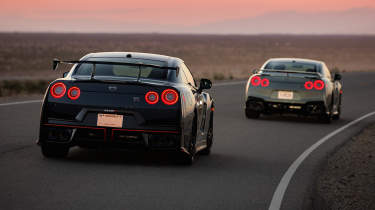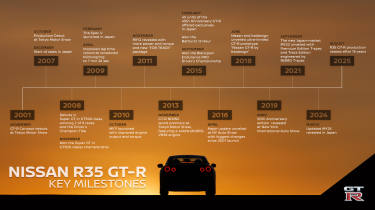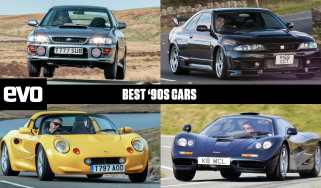The Nissan GT-R is finally dead after 18 years
The Nissan GT-R has finally ended production, at over 48,000 units after 18 years on sale. It’ll be missed.

It’s a real moment in history and the end of an era, this. For the first time in 18 years, Nissan’s Tochigi plant is not producing the R35 Nissan GT-R. The very last example rolled off the assembly line in August 2025, marking the end of what is now Japan's longest serving supercar.
Around 48,000 GT-Rs have been built in that time, with 37 per cent of them finding homes in their native Japan. It makes sense then, that the Japanese market was one of the last to retain the GT-R after sales ended in the UK as far back as 2022. The UK and Europe didn’t get the GT-R’s final facelift, which was introduced in 2023 primarily for the Japanese market and North America where the car returned for a swansong after a brief hiatus.
This being a Japanese supercar, the true beginning of the GT-R’s story goes much further back than the start of production in 2007. Its rocky gestation actually began with the introduction of the GT-R Concept at the Tokyo Motor Show in November 2001.

The show car signalled Nissan’s intention to create a successor to the R34 Skyline GT-R, albeit one that turned GT-R into a pseudo supercar brand all on its own, rather than a flagship spec level for a sports saloon/coupe. The GT-R Proto arrived in November 2005 as a much more production representative concept but still not quite there. The car that would be built and sold to eager customers arrived in November 2007.
Driving generations of Nissan GT-R
- Nissan Skyline GT-R Nismo 400R (1997) review – the JDM icon with a hypercar price
- Nissan Skyline GT-R R34: review, history and specs of an icon
- Nissan GT-R (R35, 2009 - 2022) review – the Porsche 911 Turbo’s greatest rival
- Nissan GT-R Nismo (R35, 2014 - 2025) review – Godzilla on steroids is a Japanese icon
It’s fair to say it took the world by storm, going to battle with the 997 Turbo on Porsche’s home turf in setting a sensational 7min 38sec time around the Nürburgring Nordschleife. It then broke its own record on JDM production car tyres by a further nine seconds, then again by a further three seconds. It speaks to Nissan’s approach of constant iteration with the GT-R.
The power bumps began in short order, the production car rising from 478bhp to 523bhp in 2010, then 542bhp in 2012, then 562bhp in 2017. Nismo models got as powerful as 592bhp. The GT-R was famously tunable, though Nissan claimed its engine management software was uncrackable at the time of its release.
Chassis revisions were continuous, with the GT-R getting gradually more compliant and broadly capable as the years wore on. The car was a celebrated accelerator, too. It joined an incredibly exclusive club of cars that could hit 62mph in under three seconds, along with the Bugatti Veyron and 997 Porsche 911 Turbo S.

That accelerative capability was in part informed by the drivetrain, sending the twin-turbo VR38DETT 3.8-litre V6’s prodigious punch to all four wheels via a dual-clutch transmission and the ATTESA ET-S all-wheel-drive system.
Nissan GT-R vs rivals
It wasn’t the numbers or the spectacular performance potential that endeared the GT-R to us at evo though. It's the fact it was a properly engaging, thrilling driver’s car. Quite the opposite to many reports at the time of its introduction, that the GT-R was a computerised and distant driving experience, its intuitive and analogue feel makes it a car you engage with on instinct. Nevermind the ghost in the machine, the GT-R for all its cleverness feels as alive and organic as a 911 GT3. That’s probably why it won evo Car of the Year in 2008 (issue 125) – that and the accessible price point it arrived at, which increased substantially over the years.
'In the end, the mighty Nissan GT-R cannot be denied its victory,' wrote contributing editor David Vivian. 'No, it didn't ignite the fires of lust like the Alfa and Lambo. Its styling is perhaps an acquired taste. But, the truth is, there isn't another performance car on the planet that's as devastatingly cost-effective as the Nissan. It covers all the bases from four-seater GT to rocketship with breathtaking confidence. And, more significantly, its remarkable abilities can be accessed, enjoyed and afforded by the many rather than the few. Head rules heart but, on this occasion, we wouldn't have called it any other way.'

Its appeal endured over the years as the car got better and better with every model year update. It was a huge influence on the market around it, proving along with Bugatti and McLaren that turbocharging was the way forward in the horsepower wars. Yet it also influenced a turbocharging pioneer – without it, the 911 Turbo would probably be a very different car to the wide, squat supercar baiter we know today.
Even 18 years on, while the looks and cabin of the Nissan GT-R show their age, the driving experience is as engaging as ever. It’ll be sorely missed and surely in this era of hybridisation and electrification, it’ll be difficult if not impossible to replace.




